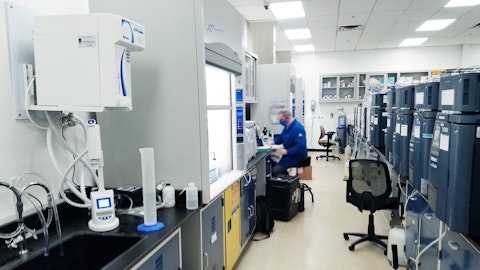And that’s important because the economics of selling that enzyme along with the template are so much more advantageous for us. So we’ve had some first successful evaluations of that platform. The first one was actually with Kudo. And we’re seeing some follow-on evaluations now. And the readouts have been fantastic. And we had a readout last week from one of our customers on the template. And as Jim noted in his prepared remarks, we actually met or exceeded all specs. And our time to manufacture beat everyone else that they were looking at. So it’s quite promising.
Operator: Our next question comes from the line of Dipesh Patel with H.C. Wainwright.
Dipesh Patel : Regarding Slide 9, just a follow-up question. Are you able to share more color on the percentage of your customers that you have in the U.S. and the ex-U.S.? And how might you expect this to trend over the coming quarters?
Dr. James Hayward: Yes, the bulk of our customers are U.S. at the moment. But with a good smattering of international customers coming both from Asia and from the European Union, I expect that we’ll see more from the European Union over the course of the next year or so. And while we profiled in Slide 9 only 6, we have many more customers than that. And what’s really compelling is that many of those customers are returning for additional orders and for orders of greater volume.
Dipesh Patel : Great. And then last question. With regards to the projection that you noted of up to $15 million annual for the Linea IVT revenue, what assumptions can we kind of take away from that in terms of are you putting in like 100% utilization of the 1,000 square foot facility that you mentioned?
Dr. James Hayward: Yes, the capacity is actually slightly greater than that at 100% utilization. Of course, you never want to get to 100% utilization, but the facilities are quite clonable, if you’ll pardon the pun. And it would be easy to prepare additional space. I can see a future where customers are beginning to lay out their plans for pharmacokinetics and toxicology and clinical trials, and their approach to FDA. And not only will they be placing orders, but I suspect they’ll be booking time. And so as that begins to happen, we have to ensure that we have the capacity to accommodate more time, as it were. And that’ll be a straightforward process. We’ve already mapped out how to do it. So we’re set and ready to go.
Operator: [Operator Instructions] Our next question comes from the line of Jeffrey Bernstein with Silverberg Bernstein Capital.
Jeffrey Bernstein: I just wanted to understand when you talked about being benchmarked against competitors and having a higher speed of production, are we talking about the enzymatic guys like Twist and Anza, those kinds of folks?
Clay Shorrock: I’ll take that, Jim, if you want.
Dr. James Hayward: Sure.
Clay Shorrock: Okay. So yes and no. We’re talking about some of our competitors in the enzymatic scale-up, not the enzymatic synthesis. So we don’t know which customers they are particularly. All we know is that we are being benchmarked against other enzymatic manufacturers and we are exceeding their, like, turnaround time.
Jeffrey Bernstein: Okay. So those would potentially be like CDMOs that are offering these capabilities?
Clay Shorrock: Exactly, right. So – and again, there are 2 enzymatic uses. There’s the synthesis of that initial template, which is not what we do. And then there’s use of enzymatic manufacturing to scale up, which is what we do. So it’s [indiscernible].
Operator: [Operator Instructions] This concludes our question-and-answer session. I would like to turn the conference back over to James Hayward for any closing remarks.
Dr. James Hayward: Well, thank you all for joining us. And we look forward to keeping you closely apprised as we move ahead through these exciting times. Thank you.
Operator: The conference is now concluded. Thank you for attending today’s presentation. You may now disconnect.
Follow Bnb Plus Corp. (NASDAQ:BNBX)
Follow Bnb Plus Corp. (NASDAQ:BNBX)
Receive real-time insider trading and news alerts




